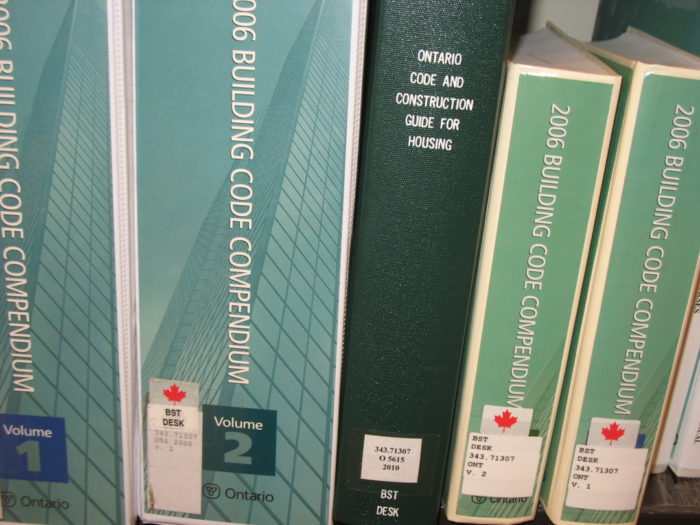
Image Credit: Toronto Public Library
Revisions planned for the Ontario Building Code will increase energy efficiency in new homes, close existing efficiency loopholes for high-rise buildings, and reduce greenhouse gas emissions.
A post at the website Lexology says that the proposed changes, which are scheduled to go into effect on January 1, 2019, are designed to support the government’s 2016 Climate Change Action Plan by moving new construction closer to net-zero energy performance and making it harder for developers to build high-rise buildings with inefficient glass curtain walls.
Two key amendments will require that new large buildings have roof designs that can handle the increased loads of solar equipment, and obligate builders to include conduit on new houses for the eventual installation of solar panels or a solar hot-water system.
The idea, the post says, is to include these steps during construction rather than turn them into expensive upgrades later. The changes were announced on July 14 by the Ministry of Municipal Affairs, which opened a public comment period extending to Sept. 29.
The Solar Ready Guidelines were worked out jointly by National Resources Canada and the Canadian Solar Industries Association. Pilot projects designed to explore the impact of the guidelines found that “a few simple, inexpensive design modifications made up front in the design and construction phase of a new home enabled building owners to significantly save on future installation costs of a solar domestic hot water system or photovoltaic system.” Savings for a typical home added up to $1,000.
Making building envelopes tighter
Starting in 2020, the code would begin to close a loophole that currently allows builders to substitute high-efficiency heating equipment for less efficient building envelopes. In the current code, builders following the performance path to code compliance can get away with a leaky or under-insulated building envelope as long as they install high-efficiency HVAC systems. This, the post explains, is a problem in condos and apartment buildings where developers want the aesthetics of floor-to-ceiling windows that reduce energy performance and are willing to pay for them with better HVAC equipment.
Proposed changes would make these trade-offs less likely, and eliminate them completely by 2022. After that, builders could compensate for weaknesses in the building envelope only with enhancements to the building envelope, not with better mechanical systems. Poorly performing windows, for example, would have to be offset by more insulation.
Also beginning in 2022, heat or energy recovery ventilators would be required in apartment buildings and condos to compensate for tighter buildings that allow fewer fresh air leaks. HRVs and ERVs pull fresh air from outdoors through a heat exchanger to minimize energy losses: in winter, for example, warm air from inside the house heats up incoming air from outdoors before it’s expelled.
Other changes target continuous insulation, energy-efficient windows and air tightness requirements.
After the public comment period ends, a technical advisory panel will offer suggestions as the new requirements are readied for a 2019 launch. However, the post notes that proposed changes could be upended by provincial elections next spring.
Weekly Newsletter
Get building science and energy efficiency advice, plus special offers, in your inbox.














One Comment
EV charging is also included in OBC updates
Section 9.34.1.6 will see the provision for mandatory EV charging in all houses and duplex units, as of Jan 1, 2018. 240V, 50A service into the garage. It will also require minimum 200A panels for each unit.
Log in or create an account to post a comment.
Sign up Log in